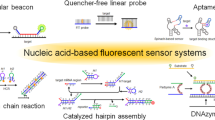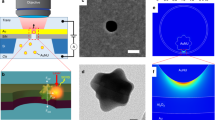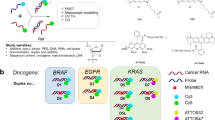Abstract
Here we describe a hybrid material composed of a single-stranded DNA (ssDNA) molecule, a 1.4 nm diameter gold nanoparticle, and a fluorophore that is highly quenched by the nanoparticle through a distance-dependent process. The fluorescence of this hybrid molecule increases by a factor of as much as several thousand as it binds to a complementary ssDNA. We show that this composite molecule is a different type of molecular beacon with a sensitivity enhanced up to 100-fold. In competitive hybridization assays, the ability to detect single mismatch is eightfold greater with this probe than with other molecular beacons.
This is a preview of subscription content, access via your institution
Access options
Subscribe to this journal
Receive 12 print issues and online access
$209.00 per year
only $17.42 per issue
Buy this article
- Purchase on Springer Link
- Instant access to full article PDF
Prices may be subject to local taxes which are calculated during checkout




Similar content being viewed by others
References
Mirkin, C.A., Letsinger, R.L., Mucic, R.C. & Storhoff, J.J. A DNA-based method for rationally assembling nanoparticles into macroscopic materials. Nature 382, 607–609 (1996).
Alivisatos, A.P. et al. Organization of nanocrystal molecules using DNA. Nature 382, 609–611 (1996).
Mitchell, G.P., Mirkin, C.A. & Letsinger, R.L. Programmed assembly of DNA functionalized quantum dots. J. Am. Chem. Soc. 121, 8122–8123 (1999).
Whaley, S.R., English, D.S., Hu, E.L., Barbara, P.F. & Belcher, A.M. Selection of peptides with semiconductor binding specificity for directed nanocrystal assembly. Nature 405, 665–668 (2000).
Schultz, S., Smith, D.R., Mock, J.J. & Schultz, D.A. Single-target molecule detection with nonbleaching multicolor optical immunolabels. Proc. Natl. Acad. Sci. USA 97, 996–1001 (2000).
Elghanian, R., Storhoff, J.J., Mucic, R.C., Letsinger, R.L. & Mirkin, C.A. Selective colorimetric detection of polynucleotides based on the distance-dependent optical properties of gold nanoparticles. Science 277, 1078–1081 (1997).
Storhoff, J.J., Elghanian, R., Mucic, R.C., Mirkin, C.A. & Letsinger, R.L. One-pot colorimetric differentiation of polynucleotides with single base imperfections using gold nanoparticle probes. J. Am. Chem. Soc. 120, 1959–1964 (1998).
Andrew, T.A., Mirkin, C.A. & Letsinger, R.L. Scanometric DNA array detection with nanoparticle probes. Science 289, 1757–1760 (2000).
Loweth, C.J., Caldwell, W.B., Peng, X.G., Alivisatos, A.P. & Schultz, P.G. DNA-based assembly of gold nanocrystals. Angew. Chem. Int. Edn. Engl. 38, 1808–1812 (1999).
Niemeyer, C.M., Burger, W. & Peplies, J. Covalent DNA–Streptavidin conjugates as building blocks for novel biometallic nanostructures. Angew. Chem. Int. Edn. Engl. 37, 2265–2268 (1998).
Storhoff, J.J. et al. What controls the optical properties of DNA-linked gold nanoparticle assemblies? J. Am. Chem. Soc. 122, 4640–4650 (2000).
Tyagi, S. & Kramer, F.R. Molecular beacons: probes that fluoresce upon hybridization. Nat. Biotechnol. 14, 303–308 (1996).
Bonnet, G., Tyagi, S., Libchaber, A. & Kramer, F.R. Thermodynamic basis of the enhancement specificity of structured DNA probes. Proc. Natl. Acad. Sci. USA 96, 6171–6176 (1999).
Bonnet, G., Krichevsky, O., & Libchaber, A. Kinetics of conformational fluctuations in DNA hairpin-loops. Proc. Natl. Acad. Sci. USA 95, 8602–8606 (1998).
Marras, S.A.E., Kramer, F.R. & Tyagi, S. Multiplex detection of single-nucleotide variations using molecular beacons. Genet. Anal.-Biomol. E. 14, 151–156 (1999).
Steemers, F.J., Ferguson, J.A. & Walt, D.R. Screening unlabeled DNA targets with randomly ordered fiber-optic gene array. Nat. Biotechnol. 18, 91–94 (2000).
Tyagi, S., Bratu, D.P. & Kramer, F.R. Multicolor molecular beacons for allele discrimination. Nat. Biotechnol. 16, 49–53 (1997).
Vet, J.A.M. et al. Multiples detection of four pathogenic retroviruses using molecular beacons. Proc. Natl. Acad. Sci. USA 96, 6394–6399 (1999).
Gersten, J. & Nitzan, A. Spectroscopic properties of molecules interacting with small dielectric particles. J. Chem. Phys. 75, 1139–1152 (1981).
Weitz, D.A., Garoff, S., Gersten, J.I. & Nitzan, A. The enhancement of Raman scattering, resonance Raman scattering, and fluorescence from molecules adsorbed on a rough silver surface. J. Chem. Phys. 78, 5324–5338 (1983).
Moskovits, M. Surface-enhanced spectroscopy. Rev. Mod. Phys. 57, 783–826 (1985).
Bonnet, G. & Libchaber, A. Optimal sensitivity in molecular recognition. Physica A 263, 68–77 (1999).
Chance, R.R., Prock, A. & Silbey, R. Molecular fluorescence and energy transfer near interfaces. Adv. Chem. Phys. 37, 1–65 (1978).
Lakowicz, J.R. Principles of fluorescence spectroscopy, Edn 2. (Kluwer Academics, New York; 1999).
Kreibig, U. & Vollmer, M. Optical properties of metal clusters. (Springer-Verlag, Berlin; 1995).
Doremus, R.H. Optical properties of small gold particles. J. Chem. Phys. 40, 2389–2396 (1964).
Chang, S.-S., Shih, C.-W., Chen, C.-D., Lai, W.-C. & Chris Wang, C.R. The shape transition of gold nanorods. Langmuir 15, 701–709 (1999).
Lyon L.A. et al. Raman spectroscopy. Anal. Chem. 70, 341R–361R (1998).
Hainfeld, J.F. Undecagold-antibody method. In Colloidal gold: principles, methods and applications, Vol.2. (ed. Hayat, M.A.) 413–429 (Academic Press, San Diego, CA; 1989).
Acknowledgements
We thank G. Bonnet for enlightening discussions and suggestions, and for his help with the fluorescence correlation spectroscopy measurements. We thank R. Bar-Ziv, G.V. Shivashankar, T. Tomoda, and A. Mehta for interesting discussions. The help of A. Roll-Mecak and D. Stettler was instrumental in the final writing of this manuscript. We also thank the reviewers for improvement to the manuscript. This research was supported by the Mathers Foundation.
Author information
Authors and Affiliations
Corresponding author
Rights and permissions
About this article
Cite this article
Dubertret, B., Calame, M. & Libchaber, A. Single-mismatch detection using gold-quenched fluorescent oligonucleotides. Nat Biotechnol 19, 365–370 (2001). https://doi.org/10.1038/86762
Received:
Accepted:
Issue Date:
DOI: https://doi.org/10.1038/86762
This article is cited by
-
Intramolecular charge transfer enables highly-efficient X-ray luminescence in cluster scintillators
Nature Communications (2023)
-
Rhodamine B functionalized silver nanoparticles paper discs as turn-on fluorescence sensor, coupled with a smartphone for the detection of microbial contamination in drinking water
Environmental Monitoring and Assessment (2023)
-
Multifunctional Gold Nanoparticles for Improved Diagnostic and Therapeutic Applications: A Review
Nanoscale Research Letters (2021)
-
Research advances and applications of biosensing technology for the diagnosis of pathogens in sustainable agriculture
Environmental Science and Pollution Research (2021)
-
Detection of energy transfer mechanisms in nanoscopic optical rulers
Journal of Nanoparticle Research (2020)



